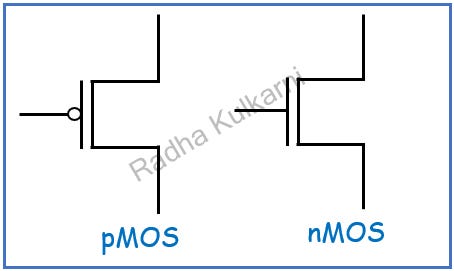In the realm of VLSI circuit design, understanding CMOS (Complementary Metal-Oxide-Semiconductor) logic circuits is crucial. CMOS circuits are built using two types of transistors: nMOS (negative-channel Metal-Oxide-Semiconductor) and pMOS (positive-channel Metal-Oxide-Semiconductor). Let’s delve into the intricacies of CMOS logic design and explore how theory translates into practical circuitry.

- Working Principles of nMOS and pMOS Transistors:
- nMOS: When the gate voltage is “0,” the nMOS transistor is OFF, acting as an open circuit. Conversely, with a gate voltage of “1,” it turns ON, behaving like a short circuit.
- pMOS: With a gate voltage of “0,” the pMOS transistor is ON, acting as a short circuit. When the gate voltage is “1,” it becomes OFF, akin to an open circuit.
- Structure of CMOS Circuits:

- CMOS circuits consist of a pull-up network made of pMOS transistors and a pull-down network made of nMOS transistors.
- The pull-up network connects to Vdd (the supply voltage) while the pull-down network connects to GND (ground).
- The output is derived from the connection between the pull-up and pull-down networks.
- pMOS transistors are efficient at passing logic high signals, while nMOS transistors excel at passing logic low signals.
- Due to the inherent inverting nature of CMOS, an inverter circuit is typically added at the output to obtain a non-inverted signal.
- Basic Logic Circuit Rules:
In CMOS logic design, two fundamental operations are performed:
- The “ . “ operation, also known as the AND operation, involves connecting pMOS transistors in parallel and nMOS transistors in series.
- The “ + “ operation, or OR operation, connects nMOS transistors in parallel and pMOS transistors in series.
- Examples:
- NAND Gate

2. NOR Gate

“Stay tuned for more examples and insights into CMOS logic design as we continue to explore the fascinating world of VLSI circuitry.”
In conclusion, understanding the intricacies of CMOS logic circuits, including the working principles of nMOS and pMOS transistors, the structure of CMOS circuits, and the basic logic circuit rules, is essential for anyone delving into VLSI circuit design. By grasping how theory translates into practical circuitry, we gain insights into creating efficient and robust digital systems.
Thank you for joining us on this exploration of CMOS logic design, and we look forward to sharing more knowledge and insights with you in the future.
No comments:
Post a Comment